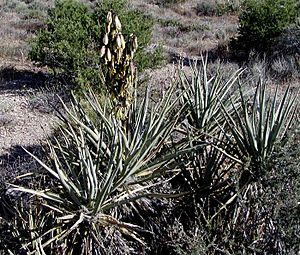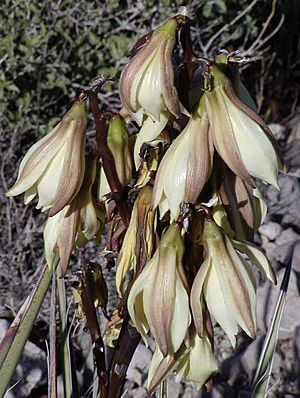Banana yucca facts for kids
Quick facts for kids Banana yucca |
|
|---|---|
 |
|
| Yucca baccata at Red Rock Canyon | |
| Conservation status | |
| Scientific classification | |
| Synonyms | |
|
Yucca baccata (datil yucca or banana yucca, also known as Spanish bayonet) is a common species of yucca native to the deserts of the southwestern United States and northwestern Mexico, from southeastern California north to Utah, east to western Texas and south to Sonora and Chihuahua. It is also reported in the wild in Colombia.
The species gets its common name "banana yucca" from its banana-shaped fruit. The specific epithet "baccata" means 'with berries'. Banana yucca is closely related to the Mojave yucca (Y. schidigera), with which it is interspersed where their ranges overlap; hybrids between them occur.
Contents
Description
Yucca baccata is recognized by having leaves 50–76 cm (20–30 in) long with a blue-green color, and short or nonexistent trunks. It flowers in the spring, starting in April to July depending on locality (altitude), and the flowers range from 5 to 13 cm long, white to cream with purple shades. The flower stalk is not especially tall, typically 1–1.5 meters. The seeds are rough, black, wingless, 3–8 mm long and wide, 1–2 mm thick; they ripen in 6–8 weeks. The indehiscent fleshy fruit is 8–18 cm long and 6 cm across, cylindrical, and tastes similar to sweet potato.
It is a larval host to the ursine giant skipper, yucca giant skipper, and various yucca moths (Proxodus sp.). After feeding, the skippers pupate in the yucca's roots.
Subspecies
Yucca baccata has been divided into three subspecies:
- Yucca baccata ssp. baccata—Datil Yucca, Banana Yucca
- Yucca baccata ssp. thornberi (McKelvey) Hochstätter—Thornber's Yucca
- Yucca baccata ssp. vespertina (McKelvey) Hochstätter—Mohave Datil Yucca
Distribution
The plant is known from the Great Basin, the Mojave, Sonoran, and Chihuahuan Deserts, plus the Arizona/New Mexico Mountains ecoregion and lower, southern parts of the Rocky Mountains. It occurs primarily in the states of Utah, California, Nevada, Arizona, Colorado, New Mexico, and Texas in the United States, and the state of Chihuahua in Mexico. It can be found in several habitat types including Pinyon-Juniper, desert grassland, Creosote bush scrub, Sagebrush, and Ponderosa pine colonies at elevations generally between 1,500 and 2,500 meters.
It is associated with Yucca schidigera, Yucca brevifolia, Yucca arizonica, Yucca faxoniana, Agave utahensis, and other Agave species. It can be found among Sclerocactus, Pediocactus, Navajoa, and Toumeya species.
Yucca baccata occurs in a large area of the North American deserts and exhibits much variation across its range. Yucca baccata specimens from the higher, mountainous regions of the Rocky Mountains is winterhardy and tolerates extreme conditions.
Uses
The Paiutes dried the fruits for use during the winter. It is still a popular food amongst Mexican Indians.
The young flower stalks can be cooked and eaten, with the tough outer rind discarded. The fruit can be eaten raw or cooked.
See also
 In Spanish: Yucca baccata para niños
In Spanish: Yucca baccata para niños



